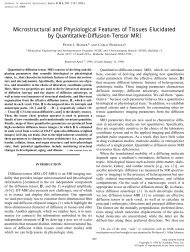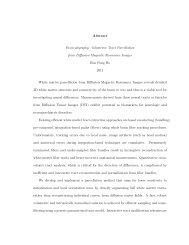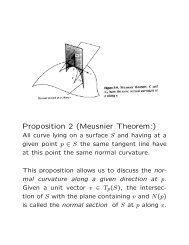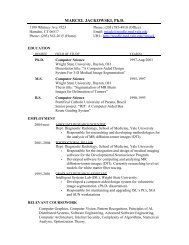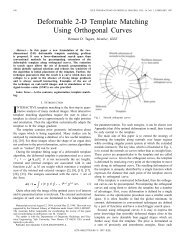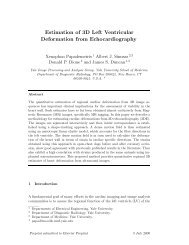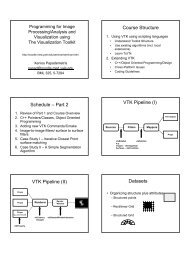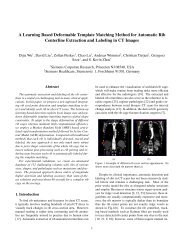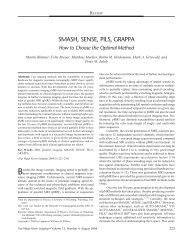Pulsed-field gradient nuclear magnetic resonance as a tool for ...
Pulsed-field gradient nuclear magnetic resonance as a tool for ...
Pulsed-field gradient nuclear magnetic resonance as a tool for ...
You also want an ePaper? Increase the reach of your titles
YUMPU automatically turns print PDFs into web optimized ePapers that Google loves.
212<br />
PRICE<br />
( ) [ ( )]<br />
Table 4 g t <strong>for</strong> the Stejskal and Tanner Sequence <strong>for</strong> Sinusoidally Shaped Gradient Pulses see Fig. 10 B<br />
Ž. 2<br />
Subinterval of Pulse Sequence Sine-shaped g t Sine -shaped gŽ. t<br />
0 t t1 0 0<br />
Ž Ž . . Ž Ž . . 2<br />
t1tt1 g sin Ntt1 gsin Ntt1 <br />
t1tt1 0 0<br />
t tt g sinŽNtt Ž . . gsinŽNtt Ž . .<br />
1 1 1 1<br />
t1t2 0 0<br />
2N Ž N is an integer. denotes the period of the <strong>gradient</strong> pulse. The corresponding echo attenuation equations are given by Eqs.<br />
13 and 14 .<br />
reference ph<strong>as</strong>e-angle evolution can then be subtracted<br />
from all subsequent spectra obtained under<br />
the same conditions to remove the effect of<br />
B variation Ž 52 .<br />
0<br />
. Other variations b<strong>as</strong>ed on deconvolution<br />
using an experimental reference exist<br />
Ž 53 . .<br />
In work related to the helix picture of magnetization<br />
subjected to a constant <strong>gradient</strong> Ž 29 . ,<br />
Callaghan developed the MASSEY sequence<br />
Ž 21. <strong>for</strong> minimizing ph<strong>as</strong>e instability in very-high<strong>gradient</strong><br />
NMR spectroscopy Ž Fig. 11 . . The method<br />
also corrects <strong>for</strong> sample movement Žsee<br />
Sample<br />
Movement with Respect to the Gradient . . This<br />
method incorporates a read <strong>gradient</strong> Ži.e.,<br />
k space;<br />
this usage of k is not to be confused with the<br />
exponential rate constant used above . , G, into the<br />
standard Stejskal and Tanner sequence; thus, in a<br />
sense, it is also a pulse sequence solution and not<br />
only a postprocessing solution. It is important to<br />
realize that in this method the same <strong>gradient</strong> coil<br />
is used <strong>for</strong> generating the <strong>gradient</strong> pulses and<br />
also the read <strong>gradient</strong>. The addition of G allows<br />
<strong>for</strong> the restoration of spatially dependent ph<strong>as</strong>e<br />
shifts such <strong>as</strong> those caused by a mismatch in the<br />
Ž .<br />
q-space <strong>gradient</strong> pulses. To understand how this<br />
method works, we need to consider the mathematics<br />
behind the ph<strong>as</strong>e-twist problem. We start<br />
from the average propagator representation of<br />
the short <strong>gradient</strong> pulse approximation Žsee<br />
Eq.<br />
87 , Part 1 . , except we now include the effects of<br />
a ph<strong>as</strong>e shift, , due to the effects of a <strong>gradient</strong><br />
mismatch see<br />
Amplifier Noise, Earth Loops, and<br />
Nonreproducible Ž Mismatched. Gradient Pulses ,<br />
q, and of movement r of the entire Ž<br />
o<br />
i.e.,<br />
rigid. sample Žsee<br />
Sample Movement with Respect<br />
to the Gradient. between the first and second<br />
<strong>gradient</strong> pulses in the Stejskal and Tanner<br />
sequence. Thus, we have<br />
H<br />
Ž . Ž . i2 qR <br />
E q, P R, e dR 15<br />
where PŽ R, . is the average propagator and R is<br />
the dynamic displacement defined by r r Ž<br />
1 0 the<br />
starting and finishing positions of a spin with<br />
respect to the first and second <strong>gradient</strong> pulses.<br />
and<br />
Ž . Ž .<br />
2qR2 qq r Rr<br />
0 o<br />
<br />
qr . 16<br />
o<br />
Table 5 The ft ( ) Term in Eq. [ 12] <strong>for</strong> the various B0 <strong>gradient</strong> pulse shapes in the Stejskal and Tanner<br />
Sequence ( see Fig. 10) given in Table 3<br />
Ž.<br />
Gradient Pulse Shape f t<br />
Ramped rise and fall 3 2<br />
30 6<br />
2 k 2 2<br />
Exponential rise and fall 2k Ž 1k . 4Ž ke .Ž 1k 2.<br />
Ž 2 2k<br />
2 k e . Ž 1k.<br />
Exponential rise and fall with<br />
overshoot and undershoot Ž 2 3 kŽ 2 2 2<br />
8k 12k e 2 4 6 k<br />
2 2 3 8k 12k 8k 12k .. g<br />
kŽ 2 . Ž 2 . 2kŽ 2 2<br />
4e k g k e 2 6 k<br />
2 2 3. 2<br />
4k 6k 2k 3k g<br />
Ž . Ž 2 2<br />
23k g k .<br />
Sine rise and fall 2Ž . 2Ž . 2 3 3<br />
4 2 8 3 64 <br />
Ž .<br />
From Price and Kuchel 30 .<br />
2



